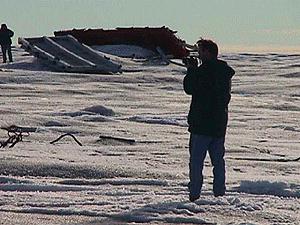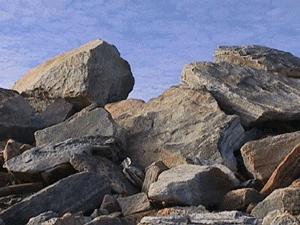21 August, 1999
Aloha, It is Saturday night at midnight and it looks like 8:00am in the
morning. The sun is out over the bay and the sky has cleared at the base.
This morning we were socked in with fog from moisture-laden air from the
ocean. We ate breakfast, where we met some Canadian military personnel here
to resupply military bases in Eureka and Alert on Ellesmere Island, Canada.
Ellesmere Island is 400 miles to the northwest of Thule.
We then took a trip to Pingarssuit Mountain. It is the highest point on
the base and Jack wanted to get a camera shot for his web site/
photographic journal of the area. It was extremely windy and cold as you
can see from the pictures, even though we were in the sunshine above the
clouds obscuring the base. Again, I was mesmerized by the rocks; Kevin
commented that this is the place where God made rocks. The pink and gray
striped stones covered the hillside. The crescent glacier glinting in the
sun also lay to one side of the mountain. (See Pic.) Before us spread the
bay and behind us the icecap.
We then went to the ice cap at Camp Tuto (short for Thule take off). This
camp was built to resupply the experimental "Camp Century", a base built
below the ice cap. Camp Century, now abandoned, was fueled by a nuclear
reactor and housed a number of military personnel. It is now just a large
freezer box a hundred miles out on to the ice cap. The snow covered most
areas, but it was melting into streams and in places revealed the azure
blue color of frozen solid ice underneath (See Pic). I crashed through the
thin ice into ankle deep water at times misjudging the strength of the
surface, but the socks that I had purchased quickly pulled the water away
from my skin. The effect is called wicking and is a property of the
synthetic material. I was amazed that my foot didn't feel wet or get cold
after the initial seconds of contact with the cold water. The ice was very
bright and we were protected from the wind by a large gravel mound. We
contemplated a friendly game of ice hockey. Looking up at the sky we
observed a sundog (See Pic.) Sundogs are formed by ice crystals present in
the 30 below zero air. The ice crystals in the atmosphere refract the
sunlight like a prism.
We then went to look for an ice tunnel that had been drilled into the
permafrost for experiments, I suppose similar to the CRREL ice tunnel in
Alaska, but with no fossils (See the July journals). The glaciers have worn
down the rock in Greenland to an age before life appeared on the planet.
This is the oldest exposed rock in the world, known as Precambrian rock.
Jack said that this has been an unusually mild summer and the ice cap looks
like it has melted down about 3-4 feet, so the entrance might now be
visible. We did find it, but the entrance cover had a small opening, which
filled the tunnel with water and refroze. It would take a bit of drilling
to get through.
We returned to the mess hall and to our barracks to see if there were any
messages as to our permit. Not yet. It looks as though we will have to wait
until Monday.

Kevin standing on the icecap taking a picutre of one of the sleds used to send supplies out to Camp Tuto, the now abandoned underground city 100 miles out on to the ice cap.

The blue area is the solid ice of the ice cap. The rocks are from the erosion of the Camp Tuto ramp built as an access to the ice cap.

A sun dog seen from out on the ice cap. This rainbow like sundog is to the right of the sun and there is another sundog on the left out of view.

The amazing rocks covering Pingarssuit Mountain.

This is a melt water stream cutting through the icecap.

Contact the TEA in the field at
.
If you cannot connect through your browser, copy the
TEA's e-mail address in the "To:" line of
your favorite e-mail package.
|
